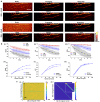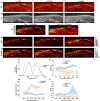Spatiotemporal singular value decomposition for denoising in photoacoustic imaging with a low-energy excitation light source
- PMID: 36589568
- PMCID: PMC9774869
- DOI: 10.1364/BOE.471198
Spatiotemporal singular value decomposition for denoising in photoacoustic imaging with a low-energy excitation light source
Abstract
Photoacoustic (PA) imaging is an emerging hybrid imaging modality that combines rich optical spectroscopic contrast and high ultrasonic resolution, and thus holds tremendous promise for a wide range of pre-clinical and clinical applications. Compact and affordable light sources such as light-emitting diodes (LEDs) and laser diodes (LDs) are promising alternatives to bulky and expensive solid-state laser systems that are commonly used as PA light sources. These could accelerate the clinical translation of PA technology. However, PA signals generated with these light sources are readily degraded by noise due to the low optical fluence, leading to decreased signal-to-noise ratio (SNR) in PA images. In this work, a spatiotemporal singular value decomposition (SVD) based PA denoising method was investigated for these light sources that usually have low fluence and high repetition rates. The proposed method leverages both spatial and temporal correlations between radiofrequency (RF) data frames. Validation was performed on simulations and in vivo PA data acquired from human fingers (2D) and forearm (3D) using a LED-based system. Spatiotemporal SVD greatly enhanced the PA signals of blood vessels corrupted by noise while preserving a high temporal resolution to slow motions, improving the SNR of in vivo PA images by 90.3%, 56.0%, and 187.4% compared to single frame-based wavelet denoising, averaging across 200 frames, and single frame without denoising, respectively. With a fast processing time of SVD (∼50 µs per frame), the proposed method is well suited to PA imaging systems with low-energy excitation light sources for real-time in vivo applications.
Published by Optica Publishing Group under the terms of the Creative Commons Attribution 4.0 License. Further distribution of this work must maintain attribution to the author(s) and the published article’s title, journal citation, and DOI.
Conflict of interest statement
T.V. is co-founder and shareholder of Hypervision Surgical Ltd, London, UK. He is also a shareholder of Mauna Kea Technologies, Paris, France.
Figures






Similar articles
-
Enhancement of in vivo cardiac photoacoustic signal specificity using spatiotemporal singular value decomposition.J Biomed Opt. 2021 Apr;26(4):046001. doi: 10.1117/1.JBO.26.4.046001. J Biomed Opt. 2021. PMID: 33876591 Free PMC article.
-
Singular value decomposition with weighting matrix applied for optical-resolution photoacoustic microscopes.Ultrasonics. 2024 Sep;143:107424. doi: 10.1016/j.ultras.2024.107424. Epub 2024 Jul 26. Ultrasonics. 2024. PMID: 39084109
-
Portable and Affordable Light Source-Based Photoacoustic Tomography.Sensors (Basel). 2020 Oct 29;20(21):6173. doi: 10.3390/s20216173. Sensors (Basel). 2020. PMID: 33138296 Free PMC article. Review.
-
Photoacoustic signal-to-noise ratio comparison for pulse and continuous waveforms of very low optical fluence.J Biomed Opt. 2022 Jul;27(7):076006. doi: 10.1117/1.JBO.27.7.076006. Epub 2022 Jul 26. J Biomed Opt. 2022. PMID: 36451701 Free PMC article.
-
Fast photoacoustic imaging systems using pulsed laser diodes: a review.Biomed Eng Lett. 2018 Mar 6;8(2):167-181. doi: 10.1007/s13534-018-0060-9. eCollection 2018 May. Biomed Eng Lett. 2018. PMID: 30603201 Free PMC article. Review.
Cited by
-
Spectroscopic photoacoustic denoising framework using hybrid analytical and data-free learning method.Photoacoustics. 2025 May 1;44:100729. doi: 10.1016/j.pacs.2025.100729. eCollection 2025 Aug. Photoacoustics. 2025. PMID: 40416360 Free PMC article.
References
LinkOut - more resources
Full Text Sources
